pt-BR
nomes no trilho de navegação

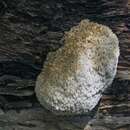
Korálovec, odborně Hericium, je rod stopkovýtrusných hub z čeledi korálovcovitých (Hericiaceae). Pro zástupce rodu jsou typické bílé nebo bělavé jednoleté plodnice s nápadným ostnitým hymenoforem a růst na dřevu (dožívající stromy, mrtvé kmeny, pařezy), na kterém působí bílou hnilobu.[1] Všechny evropské druhy se vyskytují nehojně až vzácně. Na základě biomolekulárních analýz došlo ke sloučení rodu ježatec (Creolophus) s rodem korálovec (Hericium).
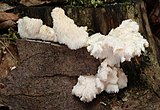 ježatec různozubý Hericium cirrhatum Evropa listnáče v ČR téměř ohrožený druh
ježatec různozubý Hericium cirrhatum Evropa listnáče v ČR téměř ohrožený druh 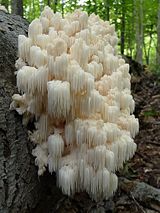 korálovec americký Hericium americanum USA
korálovec americký Hericium americanum USA  korálovec bukový Hericium coralloides Evropa listnáče (buk)
korálovec bukový Hericium coralloides Evropa listnáče (buk)  korálovec jedlový Hericium alpestre Evropa jehličnany (jedle, smrk) v ČR téměř ohrožený druh
korálovec jedlový Hericium alpestre Evropa jehličnany (jedle, smrk) v ČR téměř ohrožený druh 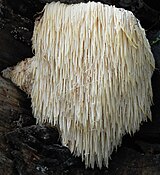 korálovec ježatý Hericium erinaceus Evropa listnáče (buk, dub) v ČR zranitelný druh, navržený k zákonné ochraně
korálovec ježatý Hericium erinaceus Evropa listnáče (buk, dub) v ČR zranitelný druh, navržený k zákonné ochraně 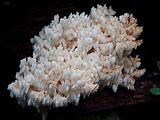 Hericium abietis USA Hericium bharengense Hericium botryoides Hericium rajchenbergii Argentina Hericium yumthangense
Hericium abietis USA Hericium bharengense Hericium botryoides Hericium rajchenbergii Argentina Hericium yumthangense Korálovec, odborně Hericium, je rod stopkovýtrusných hub z čeledi korálovcovitých (Hericiaceae). Pro zástupce rodu jsou typické bílé nebo bělavé jednoleté plodnice s nápadným ostnitým hymenoforem a růst na dřevu (dožívající stromy, mrtvé kmeny, pařezy), na kterém působí bílou hnilobu. Všechny evropské druhy se vyskytují nehojně až vzácně. Na základě biomolekulárních analýz došlo ke sloučení rodu ježatec (Creolophus) s rodem korálovec (Hericium).
Die Stachelbärte (Hericium) sind eine kleine Pilzgattung aus der Ordnung der Täublingsartigen. Ihr gemeinsames Merkmal sind frei herabhängende Stacheln, die von dem Hymenium überzogen sind. Der lateinische Name Hericium bedeutet Igel.[1]
Die Fruchtkörper sind korallenähnlich verzweigt oder besitzen lang herabhängende Stacheln. Das amyloide Trama ist fleischig bis zäh.
Die Sporen sind hyalin und ebenfalls amyloid. Sie sind kugelig bis ellipsoid geformt und besitzen eine glatte bis feinwarzige Oberfläche. Die Hyphen sind hyalin und besitzen Schnallen, teilweise auch Öltropfen.
Die wichtigsten Europäischen Arten sind:
Stachelbärte sind Xylobionten, also Holzbewohner, die als Wundparasiten an lebenden Bäumen oder an Totholz als Saprobiont wachsen. Sie fruktifizieren sehr zerstreut bis selten vom Frühsommer bis in den Spätherbst.
In China gelten die Stachelbärte als gute Speisepilze. Dort und zunehmend auch in Europa wird die Heilwirkung dieser Pilze, insbesondere des Igelstachelbarts erkannt.[2] Die Verwechslung mit Giftpilzen ist wenig wahrscheinlich. Aufgrund ihrer Seltenheit und da sie zur Zucht geeignet sind, sollten sie in freier Natur geschont werden.
Alle Arten der Stachelbärte kommen zerstreut bis selten vor. Diese Entwicklung wurde durch die Umstellung von Laub- und Laub-Nadel-Mischwäldern mit Beständen unterschiedlichen Alters zu Nadelgehölzen gleichen Alters hervorgerufen. Verstärkt wurde die Bedrohung ab Ende der 1970er-Jahre durch die mehrfache Verringerung der Umtriebszeiten alter Forste und Einzelbäumen. Vertreter der Gattung können heute fast ausschließlich nur noch in extensiv genutzten Landschaftsregionen, Naturschutzgebieten und Bannwäldern gefunden werden. Im Jahr 2021 wurden sie im Harz nachgewiesen.[3]
Die Stachelbärte (Hericium) sind eine kleine Pilzgattung aus der Ordnung der Täublingsartigen. Ihr gemeinsames Merkmal sind frei herabhängende Stacheln, die von dem Hymenium überzogen sind. Der lateinische Name Hericium bedeutet Igel.

Hericium is a genus of edible mushrooms in the family Hericiaceae. Species in this genus are white and fleshy and grow on dead or dying wood; fruiting bodies resemble a mass of fragile icicle-like spines that are suspended from either a branched supporting framework or from a tough, unbranched cushion of tissue. This distinctive structure has earned Hericium species a variety of common names—monkey's head, lion's mane, and bear's head are examples. Taxonomically, this genus was previously placed within the order Aphyllophorales, but recent molecular studies now place it in the Russulales.
Hericium means hedgehog in Latin.[1] See Wiktionary entries Hericium and ericius.

The genus Hericium was originally described by Christian Hendrik Persoon in 1794. It was mentioned by Elias Magnus Fries in the Systema Mycologicum (1822); Fries considered it to be synonymous with the tribe Merisma of the genus Hydnum. In 1825 he recognized Hericium as a distinct genus, although not in the same sense as the genus would be known later.[2] It is native to North America.
In 2004, the phylogenetic relationships of Hericium species were analysed by comparing the rDNA internal transcribed spacer sequences of H. abietis, H. alpestre, H. americanum, H. coralloides, H. erinaceum, H. erinaceus and H. laciniatum. This analysis separated H. erinaceum from the six other Hericium species, and showed that H. erinaceus, H. abietis, H. americanum, and H. coralloides are closely related each to other but genetically diverged from H. alpestre and H. laciniatum.[3] Molecular genetic markers have been developed that allow for quick and sensitive identification of Hericium species using the polymerase chain reaction.[4]
The family Hericiaceae, to which Hericium belongs, belongs to the russuloid clade of basidiomycetes, making it phylogenetically related to the Auriscalpiaceae, the Bondarzewiaceae, and the Echinodontiaceae.[5][6]
The fruit bodies typically have short stalks and are attached laterally to the host tree. Mature specimens are easily identified by drooping spines which hang down; the spines may be arranged in clusters or more usually, in rows. Positive identification of immature specimens can be more difficult as they often begin as a single clump, developing their branches as they age. They have no caps and contain spiny amyloid spores and numerous gloeopleurous hyphae filled with oil droplets.[7][8] The spores are spherical to ellipsoid, smooth or covered with very fine warts.[9]
Hericium species are found extensively in the northern parts of the world, including North America, Europe, and Asia, often growing on old, fallen logs in dark and shaded areas of deciduous and Alpine forests.[10]
Hericium species are commonly found and consumed in North America and China. The species is readily cultivated.[10] Hericium is used in the folk medicine of China and Japan,[11] but there is no high-quality clinical research as of 2020 to indicate that it has any medicinal or biological properties. The genus Hericium produces the phytochemicals, erinacines and hericenones, which are cyathane metabolites under basic research.[12]
{{cite journal}}: CS1 maint: uses authors parameter (link) {{cite journal}}: Cite journal requires |journal= (help)  Hericum at the Copernicus Science Centre in Warsaw
Hericum at the Copernicus Science Centre in Warsaw Hericium is a genus of edible mushrooms in the family Hericiaceae. Species in this genus are white and fleshy and grow on dead or dying wood; fruiting bodies resemble a mass of fragile icicle-like spines that are suspended from either a branched supporting framework or from a tough, unbranched cushion of tissue. This distinctive structure has earned Hericium species a variety of common names—monkey's head, lion's mane, and bear's head are examples. Taxonomically, this genus was previously placed within the order Aphyllophorales, but recent molecular studies now place it in the Russulales.
Hericium es un género de hongos basidiomicetos de la familia Hericiaceae, que se distribuye en bosques caducifolios y alpinos de América, Asia y Europa. Crecen en troncos de árboles viejos y lugares sombreados.[1][2]
Los cuerpos fructíferos típicamente tienen tallos cortos y están unidos lateralmente al árbol huésped. Los especímenes maduros se identifican fácilmente por las espinas caídas que cuelgan; las espinas pueden estar dispuestas en grupos o más generalmente en filas. La identificación positiva de especímenes inmaduros puede ser más difícil ya que a menudo comienzan como un grupo único, desarrollando sus ramas a medida que envejecen. No tienen tapas y contienen esporas amiloides espinosas y numerosas hifas globulares llenas de gotas de aceite. Las esporas son esféricas a elipsoides, lisas o cubiertas de verrugas muy finas. La reproducción es sexual.[3][4] El nombre del género proviene del latín que significa erizo.
Se han descrito las siguientes especies:
Hericium es un género de hongos basidiomicetos de la familia Hericiaceae, que se distribuye en bosques caducifolios y alpinos de América, Asia y Europa. Crecen en troncos de árboles viejos y lugares sombreados.
Los cuerpos fructíferos típicamente tienen tallos cortos y están unidos lateralmente al árbol huésped. Los especímenes maduros se identifican fácilmente por las espinas caídas que cuelgan; las espinas pueden estar dispuestas en grupos o más generalmente en filas. La identificación positiva de especímenes inmaduros puede ser más difícil ya que a menudo comienzan como un grupo único, desarrollando sus ramas a medida que envejecen. No tienen tapas y contienen esporas amiloides espinosas y numerosas hifas globulares llenas de gotas de aceite. Las esporas son esféricas a elipsoides, lisas o cubiertas de verrugas muy finas. La reproducción es sexual. El nombre del género proviene del latín que significa erizo.
Hericium est un genre de champignons basidiomycètes de la famille des Hericiaceae.
Selon Index Fungorum (28 mars 2020)[1] :
Hericium est un genre de champignons basidiomycètes de la famille des Hericiaceae.
Hericium Pers., 1794 è un genere di funghi Basidiomiceti appartenente alla famiglia Hericiaceae.
La specie tipo è Hericium coralloides (Scop.) Pers. (1794), altre specie incluse sono:
Hericium Pers., 1794 è un genere di funghi Basidiomiceti appartenente alla famiglia Hericiaceae.
Hericium Pers. (soplówka) – rodzaj grzybów z rodziny soplówkowatych (Hericiaceae)[1].
Saprotrofy lub słabe pasożyty rozwijające się w drewnie (powodując białą zgniliznę) i owocnikujące na jego powierzchni. Owocniki w postaci zwartej kępki długich kolców, niekiedy rozgałęzionych, nie posiadają kapelusza. Miąższ elastyczny, brudnobiały. Wysyp zarodników biały, amyloidalny. Zarodniki nieco okrągławe lub eliptyczne, od gładkich do kropkowatych, bez pory rostkowej[2].
Hericiaceae, Russulales, Incertae sedis, Agaricomycetes, Agaricomycotina, Basidiomycota, Fungi[1].
Rodzaj ten został pierwotnie (poprawnie według kodeksu ICN) zdiagnozowany jako Martela przez Michela Adansona w drugim tomie „Familles des plantes” z 1763 r[3]. Prawdopodobnie o ten sam takson chodziło Giovanniemu Scopoli w 1772, kiedy opisał rodzaj Manina i zaliczył do niego 7 gatunków: Manina cauliflora, M. columnaris, M. cordiformis, M. crispa, M. flagellum, M. muscoides i M. ramosissima[4]. Nazwy Hericium po raz pierwszy użył Christiaan Persoon w 1794. Zaliczono wtedy do niego jeden gatunek, Hericium coralloides[5]. W 1797 Persoon zalicza do tego rodzaju 10 gatunków: H. clathroides, H. coralloides, H. abietinum, H. flagellum, H. nudicaule, H. muscoides, H. caput-medusae, H. erinaceus, H. hystrix i H. echinus (większość z nich jest dziś klasyfikowana jako dwa gatunki)[6]. Elias Fries w pracy zatwierdzającej – „Systema mycologicum” z 1821 – odmówił rangi tego taksonu i opisał go jako ówczesne plemię Merisma w rodzaju Hydnum[7]. Do początku XX. wieku opisano kilkadziesiąt odrębnych gatunków należących do tego rodzaju, obecnie wiele z nich zostało utożsamionych z dwoma: H. coralloides i H. erinaceus, a kilkanaście nie zostało zweryfikowanych obecnie. Howard Banker w 1912 opublikował wyniki badań nad taksonomią rodzaju Manina, w których wykazywał potrzebę przywrócenia tego opisanego w 1772 rodzaju, zaś Hericium i Medusina uznał za późniejsze synonimy. Oprócz podanych przez Scopoliego gatunków Manina flagellum i M. cordiformis, zaliczył do tego rodzaju także M. caput-ursi, M. coralloides i M. schiedermayeri[8].
Dryodon Quél. ex P. Karst., Friesites P. Karst., Hericium Fr., Hericius Juss., Manina Scop. ex Banker, Martela Adans., Martella Endl., Medusina Chevall.
Nazwę polską – soplówka – podali Barbara Gumińska i Władysław Wojewoda w 1968 (wcześniej niektóre gatunki zwano kolczakami)[10].
Wykaz gatunków (nazwy naukowe) na podstawie Index Fungorum. Uwzględniono tylko gatunki zweryfikowane o potwierdzonym statusie[14]. Nazwy polskie według Władysława Wojewody[10].
Hericium Pers. (soplówka) – rodzaj grzybów z rodziny soplówkowatych (Hericiaceae).